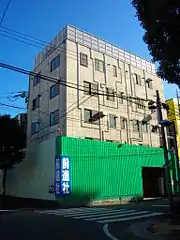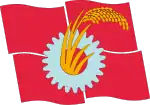Revolutionary Communist League, National Committee
Japan Revolutionary Communist League, National Committee (革命的共産主義者同盟全国委員会 Kakumeiteki Kyōsanshugisha Dōmei, Zenkoku Iinkai?) is a Japanese far-left revolutionary group, often referred to as Chūkaku-ha (中核派 Middle Core Faction) in Japanese.[1] Their main goal is to have Japan, and the entire world, adopt communist policies. Chūkaku-ha reject imperialism and the Stalinism.
Revolutionary Communist League, National Committee | |
|---|---|
 Headquarters in Edogawa, Tokyo | |
| Founded | 1950s |
| Ideology | Marxism Communism |
| Political position | Far-left |
The group is led by Takeo Shimizu, who became the chairman in 1997.[2]
The Japanese National Police Agency reports that as of 2020, 4,700 members are active in Chukaku-ha.[3]
History
Chūkaku-ha was formed in January 1957.[4] They were fervently anti-Stalinist.[5] The group believed the Stalinist form of communism, which was present in Eastern Europe, China, USSR and North Korea, did not elevate the working class as true as Marxist communism intends. Their goals at this time were to overthrow the Japanese government, stop U.S. occupation of the island of Okinawa, and abolish the Japan-US Security Alliance.[6]
The group evolved after two schisms into its current form. The first schism branched off separately from Chūkaku-ha over a disagreement between degenerated workers and formed the Communist League (CL) in 1958. In 1959 another disagreement led to the addition of National Committee to the end of the name.[4] In 1960 the Marxist Student League (MSL) would form as an unofficial youth branch of the Chūkaku-ha. This was followed in 1961 by the creation of another unofficial youth branch, the Marxist Workers' Youth League (MWYL).[4]
In 1963 another disagreement would lead to the formation of JRCL Revolutionary Marxist Faction. Also this would bring about the name Middle Core Faction, as another way of referring to Chūkaku-ha.

In 2017, the MPD announced the arrest of Masaaki Osaka, a known JRCL NC leader accused of killing a police officer during a riot on November 14, 1971.[7] On that day, a protest against the occupation of Okinawa by the United States turned violent, with students throwing Molotov cocktails at officers.[8][9]
Takeo Shimizu, one of Chukaku-ha's surviving leaders, appeared in public after going underground since 1971 on September 6, 2020 at Arakawa, Tokyo.[10][2] During a news conference on January 27, 2021, he criticizes Tokyo for its COVID-19 responses and says that the crisis is an opportunity for a revolution.[3]
Activities
Starting in 1967, Chūkaku-ha, would become active in organizing protests, usually recruiting students as their protesters from both youth organizations, MSL and MWYL.[6] Their first protest was against the Japanese Prime Minister Sato's visit to South Vietnam. In 1968, they protested the visit of the nuclear-powered aircraft carrier, USS Enterprise, to Sasebo, Japan.[11] That same year there was another protest of the Sinjuku Rail Station's transportation of US forces fuel tanks.[6]
In 1969, the organization promoted several protests at campuses across Japan. During the early 1970s the group was engaged in conflict with a rival organization known as Kakumaru. During the conflict, Kakumaru assassinated several members of Chūkaku-ha.[4] According to Chūkaku-ha, Kakumaru was aided and protected by the police.[6]
Starting in the late 1970s, the group began committing armed assaults, bombings, and destruction of infrastructure in Japan. There were a fair number of casualties and injuries as a result of the dozens of attacks they conducted. Casualties included the chairperson of Chiba prefecture's Expropriation Committee, whose death delayed the area's development(ja:千葉県収用委員会会長襲撃事件.
In 1986, their covert weapons factory was raided by police after two suspects were arrested for carrying an explosive in their truck.[12]
Their attacks continued into the later part of the 20th century, with the last one occurring in 2001.[1]
Chukaku-ha stages protests and is known to use a YouTube channel to show the rest of the world their activities.[2]
References
- "Chukakuha Revolutionary Army". Global Terrorism Database.
- http://www.asahi.com/ajw/articles/14076996
- http://www.asahi.com/ajw/articles/14143308
- "A Short History of Japan Revolutionary Communist League-National Committee (JRCL-NC)". zenshin.org. November 28, 2009.
- https://www.trackingterrorism.org/group/chukakuha
- "Introduction to Japan Revolutionary Communist League". JRCL Website.
- "Reward offered in search for killer of cop who died in Shibuya riot 45 years ago". TokyoReporter. October 31, 2016.
- Goldman, Russell (June 8, 2017). "Japan Arrests Longest-Sought Fugitive After Nearly 46 Years" – via NYTimes.com.
- "Fugitive on the run for 45 years is caught". June 7, 2017 – via www.bbc.com.
- https://www.sankei.com/smp/premium/news/201007/prm2010070009-s1.html
- "Narrative Command History of USS ENTERPRISE (CVAN-65) for 1 January 1968 to 31 December 1968" (PDF). United States Navy. Retrieved April 7, 2020.
- https://www.nytimes.com/1986/10/27/world/protests-resume-at-japan-airport.html
External links
- JRCL (Chūkaku-ha) English website
- Zengakuren, the Zengakuren faction that is loyal to JRCL (Chūkaku-ha)
